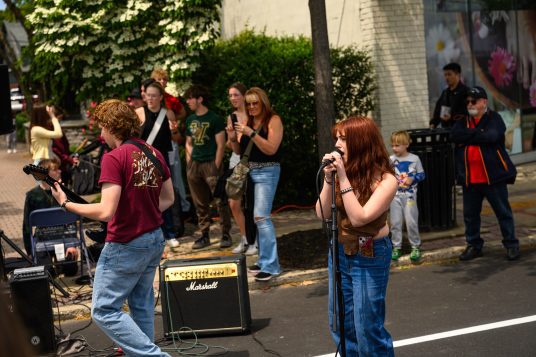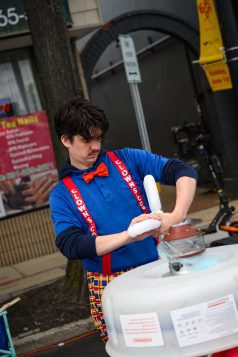Kathianne Snaden for mayor
As a Port Jefferson village resident and longtime Long Island business owner and entrepreneur, I’m proud to offer my strong support for Kathianne Snaden in her campaign for mayor.
Kathianne understands firsthand the challenges faced by our business community, whether it’s retail, restaurants or service-based industries. Having grown up in a small family-run business, she brings a deep, personal understanding of what it takes to keep a business alive and thriving. She knows that without the support of local government, small businesses can struggle to survive, especially in an ever-changing economy.
Over the years, Kathianne has proven her dedication to Port Jefferson’s business owners. Her track record speaks for itself. She listens, she shows up, and she works side by side with businesses. Whether it’s helping to navigate local regulations, advocating for improvements to our village infrastructure, or simply taking the time to hear concerns, Kathianne has been a consistent and reliable ally. Her accessibility and responsiveness have been critical in helping face both everyday challenges and larger, unexpected hurdles.
Having someone in office that understands business is crucial. I have seen unnecessary roadblocks and hurdles for local businesses that need to be addressed, so we need leaders that will take action immediately. Kathianne’s unwavering support and hands-on approach have made a real difference in our village, and I have no doubt she will continue this level of commitment as mayor.
We need leadership that prioritizes the success and sustainability of our local economy. Kathianne Snaden is that leader. She has the experience, the dedication and the heart to ensure Port Jefferson remains a vibrant and welcoming place to live, work and do business.
I urge my fellow residents to join me in voting for Kathianne Snaden for mayor. Our businesses and our community will be stronger for it.
[The election is on June 17 at Port Jefferson Village Center.]
Joe Dovi
Port Jefferson Village
Silly season returns: Port Jefferson deserves better
As we enter another mayoral election season, it’s important to remember not just of what’s at stake — but what we’ve already witnessed.
The so-called silly season is in full swing. Yard signs are sprouting across lawns, social media is ablaze and performances are taking center stage while real policy takes a backseat. But elections aren’t theater. They’re about leadership, vision, policy and results. Unfortunately, some candidates still haven’t gotten the message.
In the last election, the Snaden camp engaged in questionable behavior and sadly, it hasn’t stopped.
Let’s remember:
• Worked to kick Lauren Sheprow off the ballot;
• Used fake social media profiles — created and operated by “friends” and surrogates — to launch personal attacks and spread misinformation; and
• Behind the scenes, then-Trustee and Deputy Mayor Kathianne Snaden was making questionable decisions — most notably involving Maryhaven, a project with long-term consequences for our Village and no public transparency.
And we can’t forget one of her most visible policy failures: the PassPORT Taxi service. Snaden’s program cost the Village thousands of taxpayer dollars to subsidize local taxi rides — a plan that ended up being far more expensive and far less efficient than simply utilizing services like Uber or Lyft. What was billed as innovative transit became a financial burden with little to show in return.
It’s no wonder Snaden lost. Not because she lacked visibility or resources, but because her policy advancements were failures, and her leadership didn’t deliver for the people of Port Jefferson. Performance may win applause in the moment, but residents care about outcomes — and in that area, she fell short.
Now, two years later, they’re back — repeating the same tactics.
She’s now offering “ideas,” but let’s be clear: nothing she’s proposed addresses fiscal management, sustainability, or real forward-thinking policy. And much of what she mentions has already been done — by others. If these issues were truly urgent, where was her action in the intervening years? Why wait until campaign season to suddenly care again?
So let’s ask some hard but necessary questions:
• How is it ethical for a then sitting Trustee to be paid by the Village as a photographer during her term? That’s a clear conflict of interest, or behavior, at the very least that should have been avoided to dispel any appearance of conflict. Then, she and her surrogates spoke out against the village’s new ethics code. Hard to fathom.
• And why would a former Trustee, who prematurely announced her candidacy, remain disengaged from all meaningful Village work — sitting silently in the back of the room during meetings, offering no value, no ideas, no policy, no involvement?
And yet, it’s doubtful any minds will be changed in the village Facebook pages, where vitriol and echoes are all that matter. These digital echo chambers reward outrage over insight, loyalty over logic, and spectacle over substance.
Leadership is not seasonal. It’s not something you dust off for campaign season.
True leadership is built through consistent engagement, ethical conduct, and a genuine commitment to serving the community — not self-interest. If someone seeks your vote, they should have already been doing the work, not just appearing when it’s politically convenient.
Port Jefferson deserves better. It deserves leaders who show up, speak up, and stand up for this community — all year long.
Let’s remember the past, recognize the patterns, and vote for substance over show.
Keep Lauren Sheprow Mayor of Port Jefferson.
Drew Biondo
Former Trustee, Port Jefferson
Why we need to reelect Mayor Sheprow
As a lifelong Port Jeff resident and former village trustee, I enthusiastically support Lauren Sheprow’s reelection as mayor.
Mayor Sheprow has been a careful steward of our tax dollars. When a forensic audit of the capital fund uncovered a $1.3 million deficit left by the previous administration, she immediately put a plan in place to address the shortfall. And she still managed to keep taxes low and not exceed the tax cap, both this year and last, something that hasn’t been achieved in over a decade.
She also acted quickly to solve a long-standing problem with the carrying of firearms by our Code Enforcement personnel. The mayor worked with a unanimous board to eliminate this liability for the village, given that there is no legal authority to use guns in our village code.
One of the most distinctive achievements spearheaded by the mayor has been the creation of the Make a Difference program. These volunteer committees are filled with some of Port Jeff’s most talented residents, all of whom are devoting their time and expertise to work on the many challenges we face.
Given how effective Mayor Sheprow has proven to be in her first term, I believe she deserves the opportunity to continue her good work. We have been well served by her diligence, her dedication and her love for this village.
Please join me in reelecting Lauren Sheprow as our village mayor!
Virginia Capon
Port Jefferson Village
































